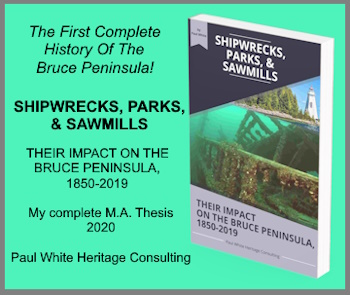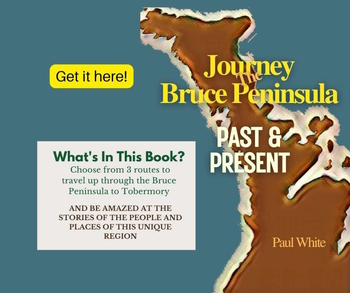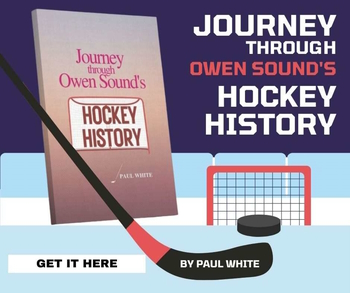Great Lakes Fishing
Georgian Bay Fishing
(baskets of fish)
Great Lakes fishing is an asset that is protected and developed, not only for its economic potential but also for those who just enjoy spending a day by the side of a river or in small fishing boats trying to catch “the big one”!
Great Lakes fishing has always been one of the region's most important economic assets. The first non-native visitors discovered that the waters of the area were teeming with vast amounts of fish. Consequently, it was not long before fishing fleets from the more settled areas of Upper Canada and the United States were making regular visits to the area. After filling their holds with thousands of fish they returned to their home ports and their cargo was trans-shipped throughout the colony or into the United States.
One of the most popular commercial fishing destinations for these fishing boats was the appropriately named "Fishing Islands" that dot the Lake Huron shoreline around the present day community of Oliphant. Early reports tell of fishing boat fleets from Goderich and Detroit arriving at the "Fishing Islands" and setting up camps and smoking stations long before area communities such as Oliphant, Southampton, and Port Elgin welcomed their first settlers.
The early settlers of Owen Sound also reaped bountiful harvests of fish. In his memoirs, A.M. Stepans, an early pioneer to the area, tells of catches that were so large that settlers had more fish than they needed to sustain them through the winter. He related that many teams of oxen hauled the excess fish for sale to settlements in the Guelph area.
The Owen Sound Comet reported in the 1850s of Tobermory fishermen coming to buy supplies and sell fish. Other early journals and diaries report of settlers relying upon the fish to supplement their diet during the long winters.
By the 1850s commercial Great Lakes fishing was an important part of the economy in Georgian Bay communities. To facilitate an efficient means of reaping the harvest of fish a unique boat was developed. George Watts, a Collingwood fisherman, designed and built a boat that would for many years become the standard vessel for area fishermen. Soon the Georgian Bay Mackinaw was a common site in the area as Watts built and sold many of these boats to commercial fishermen. They remained the most popular fishing vessel for more than two decades until the fishing industry turned to steam tugs. However, the Mackinaws and their cousins the Huron Mackinaws remained a popular choice with many fishermen.
For many years the fish harvested from Great Lakes fishing were trans-shipped out of the area to market via ships. However, the invention of the automobile and the resulting construction of a network of roadways throughout the area changed the mode of shipping fish to market. Soon fleets of trucks carried the fish to market.
Commercial fishing continued to be an important part of the economic base in many area communities well into the twentieth century.
Unfortunately, it was not long after the mid 1950s that the fishing fleets almost all disappeared from local harbours. Some blame the lamprey eel for the depletion of area fish stocks for the demise of the commercial fishing industry.
However, in the 1990s due to various projects to re-stock area waterways with fish, commercial fishing once again became a viable venture in some communities. However, the increased fish population led to another important economic boom in the area. The increase in the popularity of sport fishing led to the development of a new phenomenon, the fishing derby. Throughout the spring, summer and fall thousands of fishermen come to the area to fish for pleasure and profit.
The fishing stocks in the waters of the Bruce Peninsula region have again become a valuable commodity to the economy of this area. Therefore, it is important that Great Lakes fishing is an asset that is protected and developed not only for its economic potential but also for those who just enjoy spending a day by the side of a river or in small fishing boats trying to catch “the big one”!
Georgian Bay Shipping
List of Lighthouses on the Great Lakes: If you have names and/or pictures of Great Lakes Lighthouses please submit them along with details of their location.
Georgian Bay Ships: A List of all the ships that sailed on Georgian Bay until the 1960s. This list is not complete. If you know of a ship that sailed the waters of Georgian Bay please contact me with information about that vessel, and, if you have a picture that I could post with it, that would be much appreciated.
1885: A Memorable Summer Job for Owen Sound teenage boys on the Great Lakes would have historic importance, not mention a possible exciting career opportunity.
Hindman Transportation Company was a well-known Great Lakes shipping company for many years. Here you will find pictures of many of the Hindman ships
Owen Sound Harbour – A Photographic History, by Robert A. Cotton is a book that interests my historiographical curiosity.
Commercial Great Lakes Fishing It is probably safe to suggest that the commercial fishing industry was an important part of the early growth of this region.
A Georgian Bay fishing vacation has long been a popular attraction in the Bruce Peninsula region. During fishing derbies, the regional waterways are dotted with fishing boats of all shapes and sizes.
The Georgian Bay Mackinaw, designed by William Watts of Collingwood is an example of a Georgian Bay innovator creating a vessel to service the needs local mariners.
Great Lakes fishing is an asset that is protected and developed, not only for its economic potential but also for those who just enjoy spending a day by the side of a river or in small fishing boats trying to catch “the big one”!
Great Lakes Fishing History is not without its controversy. The impact of the fishing industry was such that it played an important role in the development of communities along the Georgian Bay and Lake Huron shoreline.
Georgian Bay Travel Before the Winter Freeze-Up could be a dangerous time for mariners in the early years in this region.
A Harbinger of Spring on the Great Lakes in pioneer times, was the eagerly awaited news that a lighthouse had been lit and shipping traffic could begin sailing from port to port.
Lumber Hookers Lumber hookers and tugs were an important innovation to improve the transportation of lumber on Georgian Bay.
Mapmakers on Georgian Bay were also explorers. They mapped the Georgina Bay shoreline noting safe harbours, dangerous reefs and other guides for sailors and pioneer settlers looking for a place to call home.
Paddling Georgian Bay & Pondering: traversing parts of this great waterway in a canoe leads one to wonder about the ships of a bygone era battling the rough seas they encountered.
Parry Sound Shipping History: The Parry Sound area has always been connected to the southern regions of the Province of Ontario by a system of good roads. Or has it?
Parry Sound’s shipping history 2 is more than the tragic sinking of the Waubuno or the later catastrophe surrounding the sinking of the Asia.
Sailing Season Closing: A Frantic Time on Peninsula as ships raced from port to port delivering and picking up passengers and produce before the waterways froze.
Ship Captain Andrew Port was not only a dynamic and brave Georgian Bay mariner, he was a personal favourite historical character of mine.
Ships Stuck in Ice: The Oak Glen was icebound in 1996 but this sailing hazard has been impacting vessels on Georgian Bay since the beginning of time.
Lake Huron shipwrecks, the Hibou often occurred in the Georgian Bay region of that Great Lake due to the often violent waters that could strike unsuspecting vessels like the Hibou.
Shipwrecks: The "Asia" wrecked off the eastern coast of Georgian Bay taking all but two of the more than 100 passengers to a watery grave.
Masters, Mates, and Pilots Association created its first Canadian chapter on Georgian Bay, providing maritime safety education, and other seafaring issues to better inform its membership.
Pioneer Travel Aboard the Fly Tells the story of a sailing vessel as the tenuous link between survival and death in a pioneer settlement in the 1840's in Upper Canada.
Sailing Stories: the Captain Who Smelled his way into Port The Captain Who Smelled his Way into Port details how pioneer seamen on Georgian Bay safely sailed the rough waters without the aid of the modern technological tools so readily used by today's mariners.
Sailing Story: The Voyage of the Prince Alfred the incredible voyage of the Prince Alfred, fraught with danger for both vessel and the crew in the winter of 1880.
Shipbuilding As the southern Georgian Bay region became more populated shipping traffic increased to meet the needs of an expanding market place.
The Summer of 1844 was No Picnic for the early settlers in the pioneer area near what would become Owen Sound on Georgian Bay.
The CPR Grain Elevator Fire of 1911 spelled the end of Owen Sound's role as the eastern terminus of the CPR Great Lakes Fleet.
Georgian Bay shipping occurred long before the first Europeans paddled these waters. But the fur and timber trades opened Georgian Bay to shipping in a big way!





